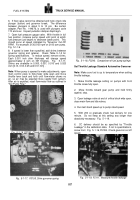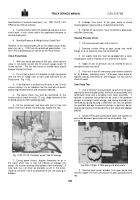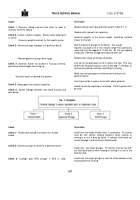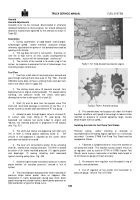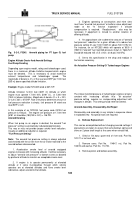TM-5-3805-254-14-P-2 - Page 539 of 894
TRUCK SERVICE MANUAL
FUEL SYSTEM
4.
Connect the fuel suction line to the suction side of the
gear pump.
Run a line from the gear pump bleed connection
to the fuel supply tank.
5.
On gear pumps not tapped, use a damper with a
tapped hole to make this connection.
6.
Shut off the fuel manifold pressure gauge to prevent
damage from over pressure.
7.
The valve in the suction line and the valve controlling
the main flow orifice are to be fully open.
All other valves must
be completely closed.
With the valves in this position, fuel will
be routed through the manifold orifice.
8.
Start the pump drive in the proper direction and run
the pump at 400 to 450 RPM.
The gear pump must pick up at
this speed without the aid of priming.
Any gear pump which
fails to pick up fuel must be reworked or replaced.
The
remaining steps of this check need not be made on any pump
failing to pick up.
9.
Increase pump speed for the following checks:
Any gear pump with delivery below the listed value should be
reworked or replaced.
Any gear pump which is wet to touch
after this check should be reworked or replaced.
Table 5-1-9: Gear Pump Flow
Gear Pump
RPM
Minimum Total
Flow
3/4 [19.05]
2100
850 Lbs./Hr.
10.
Any gear pump with a delivery above the listed
minimum is to be considered acceptable for fuel pump
operation, and it can be installed on a fuel pump for proper
calibration.
11.
The following check should be made if the gear pump
delivery is just above the listed minimum described in Step 9.
a.
The unrestricted manifold pressure should be
checked for a 10/15% higher pressure at rated speed than the
manifold pressure.
If it is too low or too high, it may be
necessary to change idle plunger (button) to give the correct
unrestricted pressure of 10/15% above final manifold pressure.
Note:
The idle plunger (counter bore diameter) may be
decreased in size to increase the amount of pressure available
at the calibration set point.
CAUTION
Step 11 is to be used only if gear pump is worn preventing
it from delivering enough pressure for proper calibration.
Never change idle plunger to exceed the 10 to 15%
unrestricted manifold pressure.
Fuel Pump Trouble Shooting With ST775 or ST848
This portion of the manual should be fully understood by the
Fuel Pump Test Stand Operator, and through this knowledge
he should be able to produce a properly calibrated Fuel Pump.
Fuel Pump calibration on the ST848 Fuel Pump Test Stand
combined with injector calibration has produced widespread
acceptance of fuel system accuracy.
There have been reports
of erratic results, but investigations have revealed that the
cause for such problems fall into three basic categories:
(1)
Mechanic and/or Testor Error, (2) Instrumentation Errors or (3)
Maintenance Status.
1.
Mechanic and/or Testor Error
a.
Misapplication of specifications and parts:
(1)
Calibrating a specific fuel pump model to the wrong
value.
(2)
Calibrating a specific injector model to the wrong flow
value.
(3)
Lack of familiarity with this bulletin (4) Use of
camshaft and pistons other than those shown in fuel pump
calibration specifications.
Note:
Pistons, camshafts and injectors are sometimes
superseded by others requiring a different calibration.
(5)
Use of wrong injector assemblies in a specific engine
model.
(6)
Use of governor and torque springs other than those
specified in fuel pump calibration data.
b.
Engine Test (1) Restricted intake air in engine.
(2)
Excessive exhaust back pressure.
(3)
Restricted fuel supply to engine.
(4)
Aerate a fuel supply to engine.
(5)
Excessive high oil level in engine crankcase.
(6)
Incorrect injector adjustment.
(7)
Dirt entering balance orifice.
2.
Instrumentation Errors
a.
Erroneous fuel manifold
pressure gauges on engine and/or chassis dynamometer.
b.
Erroneous flow meters.
c.
Erroneous dynamometer load indicators.
d.
Incorrect tachometer.
534
Back to Top




